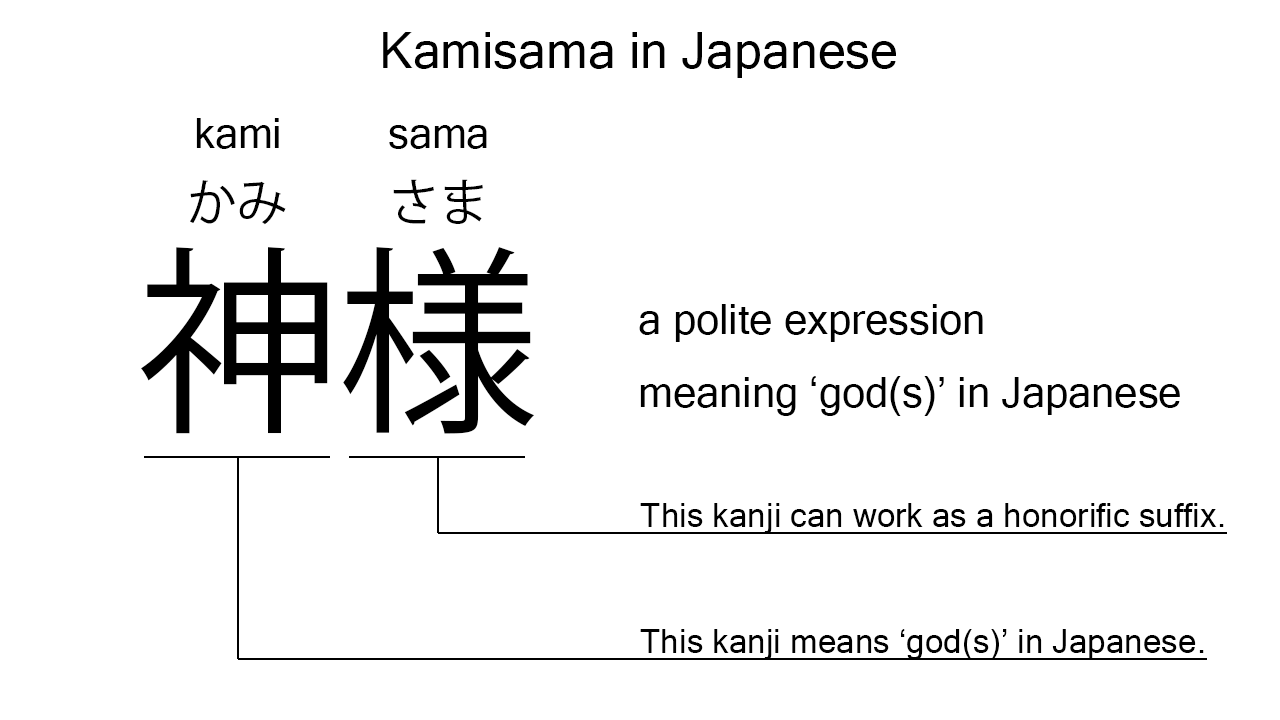What does “kamisama” mean in Japanese?
Native speakers use kamisama to mean a ‘god’ politely in Japanese. Perhaps, some Japanese learners know this polite expression as it is sometimes used in Japanese movies, songs, novels, manga, anime, and the like. In this blog post, however, I’m explaining this word in detail based on its kanji expression. And also, I’m explaining how to use it through example sentences. My explanations would help Japanese learners understand kamisama more clearly. Then, let’s get started!
Contents
Definition and meaning of “kamisama”
Let me start with the definition and meaning of kamisama.
- kamisama – 神様 (かみさま) : the polite expression of kami which means a ‘god’ in Japanese. This can also work as plural. Learn more about Japanese plural.
The definition and meaning are simple and clear. To understand this polite expression more clearly, however, let me explain its kanji characters in detail, one by one.
Kamisama in kanji
The kanji expression of kamisama consists of the following two kanji characters:
- 神 : a kanji character used to mean a ‘god’ in Japanese.
- 様 : a kanji character used as a honorific suffix to make a polite expression.
From these two kanji characters, we can understand that kamisama is literally the polite expression of kami and means a ‘god’ politely in Japanese. Japanese people often use this polite expression to show their respect to gods.

When we meet new kanji expressions, we should check their kanji characters in detail to understand their meanings clearly and deeply. In many cases, kanji characters tell us a lot about the meanings of the expressions they form. Actually, here, we could get the better understanding of kamisama through the detailed kanji check above.
So far, I’ve explained the definition and meaning of kamisama together with its kanji characters. Then, let me explain how to use it through the example sentences below.
How to say “gods” politely in Japanese
watashi tachi wa kamisama wo shinji masu – 私達は神様を信じます (わたしたちはかみさまをしんじます)
We believe in gods.
Below are the new words used in the example sentence.
- watashi – 私 (わたし) : a pronoun meaning ‘I’ in Japanese.
- tachi – 達 (たち) : a suffix used after a noun or pronoun to make its plural form. In the example, this is used after watashi to make its plural form, watashi tachi, which means ‘we’ in Japanese.
- wa – は : a binding particle working as a case marker or topic marker. In the example, this works after watashi tachi to make the subject in the sentence.
- wo – を : a case particle used to make the object word in a sentence. In the example, this is used after kamisama to make the object in the sentence.
- shinji – 信じ (しんじ) : one conjugation of the verb, shinjiru, which means ‘to believe’ in Japanese. In the example, it has been conjugated for the better connection with its following word.
- masu – ます : an auxiliary verb used after a verb to make it polite. Probably, this is well known as a part of Japanese masu form. In the example, this is used after shinji to make it sound polite.
This is a typical usage of kamisama. In this example, it works together with the case particle, wo, to become the object in the sentence.
Another example of “kamisama”
kanojo ga neko no kamisama wo mi ta – 彼女が猫の神様を見た (かのじょがねこのかみさまをみた)
She saw a cat god.
Below are the new words used in the example sentence.
- kanojo – 彼女 (かのじょ) : a pronoun meaning ‘she’ in Japanese.
- ga – が : a case particle used to make the subject word or the object word in a sentence. In the example, this is used after kanojo to make the subject in the sentence.
- neko – 猫 (ねこ) : a noun meaning a ‘cat’ in Japanese. This can also work as plural.
- no – の : a case particle used to join two nouns or noun equivalent words. Normally, the first one can work as a modifier to describe the second. In the example, this is used to join neko and kamisama. The formed phrase literally means a ‘cat god’ in Japanese.
- mi – 見 (み) : one conjugation of the verb, miru, which means ‘to see’ in Japanese. In the example, it has been conjugated for the better connection with its following word.
- ta – た : an auxiliary verb used after a verb, adjective, or auxiliary verb to make its past tense form. In the example, this is used after mi to make its past tense form, mi ta.
This is another example of kamisama. In this example, it works as a part of the noun phrase, neko no kamisama, which means a ‘cat god’ in Japanese. When we want to mean a ‘god’ politely in Japanese, anyway, kamisama is always a very good option.
Summary
In this blog post, I’ve explained the definition and meaning of kamisama in detail based on its kanji expression. And also, I’ve explained how to use it through the example sentences. Let me summarize them as follows.
- kamisama – 神様 (かみさま) : the polite expression of kami which means a ‘god’ in Japanese. This can also work as plural. The first kanji character means a ‘god’ in Japanese; the second one is a honorific suffix. So, kamisama is literally the polite expression of kami and therefore means a ‘god’ politely in Japanese.
Hope my explanations are understandable and helpful for Japanese learners.
Leave a Reply